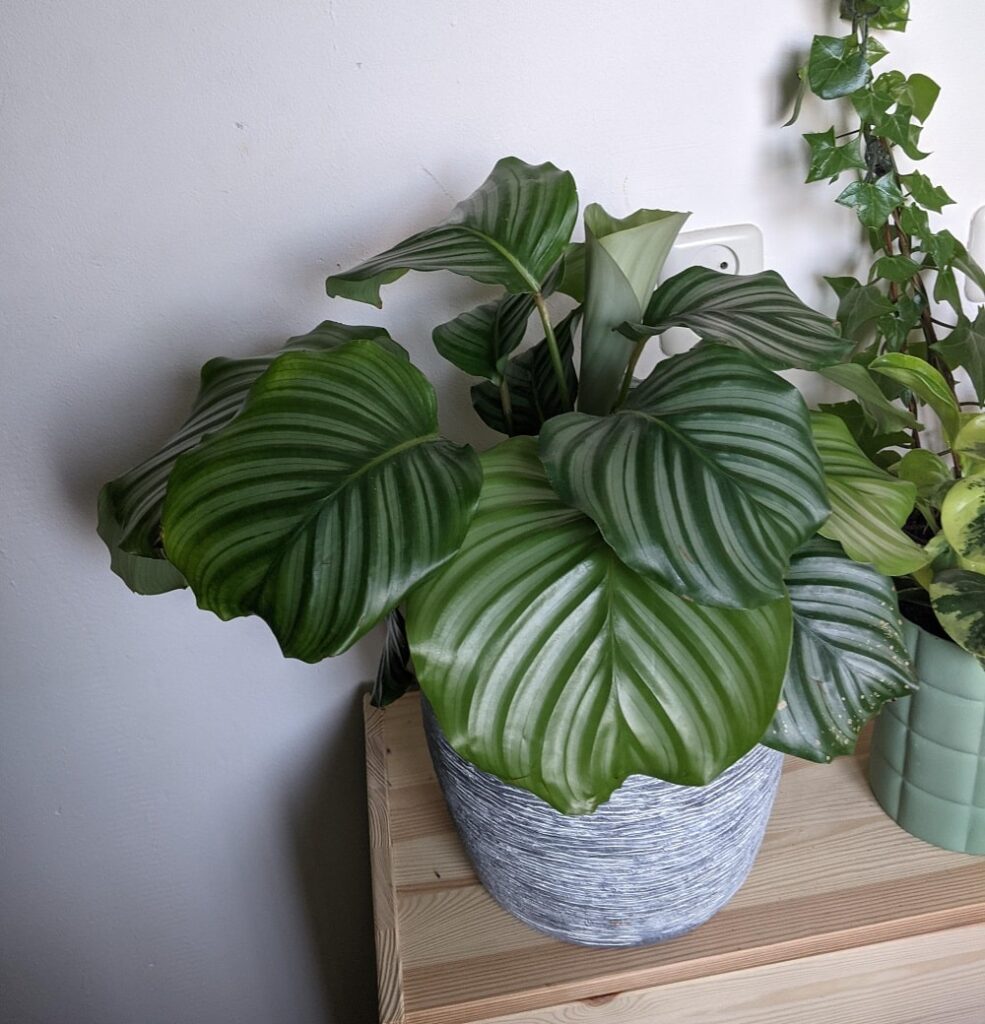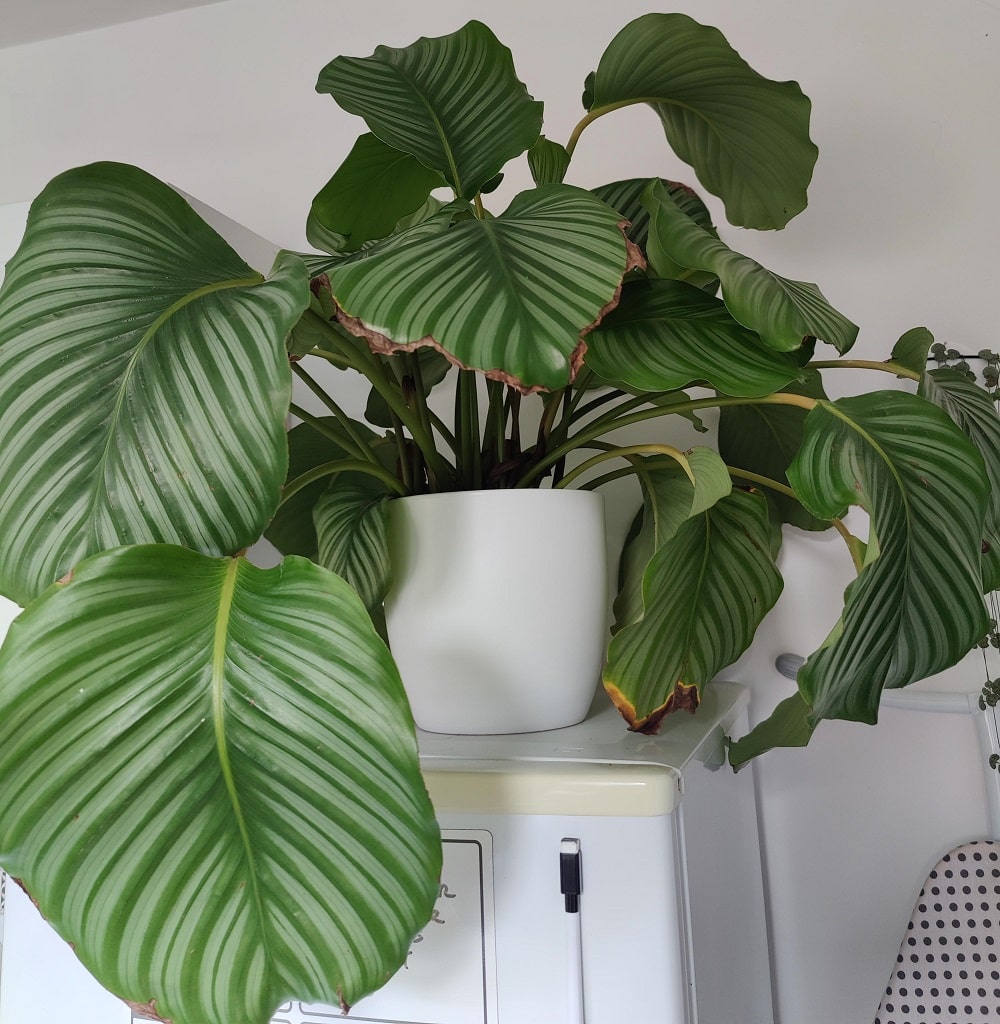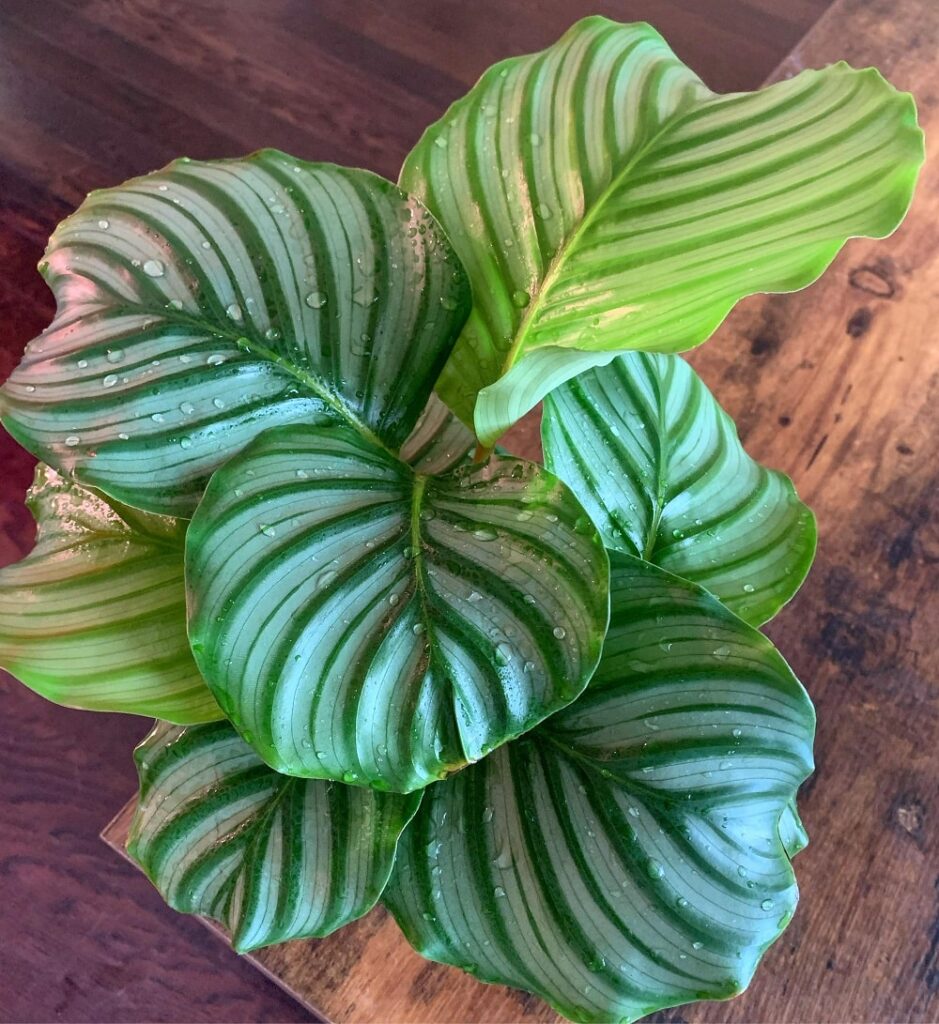Calathea orbifolia is one of the prettiest calathea species in the world. Thanks to its large and silvery green leaves with prominent dark-colored veins.
One of my favorite features about calathea orbifolia is the ease of care and maintenance. It can endure the indoor growing conditions without compromising its beauty.
Here is an ultimate calathea orbifolia care summary: The houseplant thrives in medium to bright indirect sunlight, high humidity, and well-draining soil. It also flourishes at a temperature range of 65-75oF (18-24oC) and fertilization application during the growing season.
The indoor plant can be fussy at some stage in life. I hope this calathea orbifolia care guide will help you learn how to care for the houseplant like a professional gardener. Let’s find out together:
You May Also Read: Why Is My Calathea Dying?

What Does a Calathea Orbifolia Look Like?
Calathea orbifolia is a tropical South American prayer plant with candy-striped leaves. The houseplant is native to Bolivia, and it belongs to the Marantaceae family.
The houseplant is also known as a prayer plant since it rises leaves at night to pray. The leaves folding upright behavior in the evening is known as nyctinasty.
Calathea plants are related to maranta, stromanthe, and ctenanthe plants. It is one of the reasons why many people get confused with these species of plants.
The candy-striped leaves with dark-colored veins make the plant have a stunning appearance. The plant thrives under indoor settings to mark a bold statement and bring tropical vibes.
One of my favorite features is that calathea orbifolia are fast-growing indoor plants. Besides that, this indoor plant species is non-poisonous to humans and pets.
However, calathea orbifolia rarely bloom indoors despite being a flowering plant. But many houseplant enthusiasts love the plant due to its stunning foliages.
The good news is that calathea orbifolia is quite popular. Many American and European homes have this prayer plant. The attractive foliages and well-balanced profile depend on the ultimate plant care.
You May Also Like: 15 Best Calathea Varieties with Pictures
Calathea Orbifolia Care Summary
| Origin | Tropical forest in Central and South America, Asia, and Africa. |
| Scientific Name | Goeppertia orbifolia |
| Common Names | Peacock Plant and South American Prayer Plant. |
| Type | Tropical Flowering Plant. |
| Maximum Growth | 3 feet tall. |
| Water Requirements | Moderate Watering. Use filtered water or rainwater |
| Light Needs | Medium to bright indirect sunlight |
| Humidity | High humidity to foster stunning foliage development |
| Soil | Well draining potting mix |
| Fertilizer | Monthly balanced fertilizer application during the growing season. |
| Season | Spring, fall, and summer |
| Temperature | 65°F (18°C) to 75ºF (24ºC) |
| Pruning | Minimal trimming. Prune old leaves only. |
| Propagation | By division in late spring or early summer |
| Re-potting | No need for re-potting. Less susceptible to the root-bound issues. |
| Pests and Diseases | Damp condition enhances fungus, powdery mildew, and leaf spot. More vulnerable to thrips and spider mites. |
| Toxicity | Non-toxic to humans and pets |
| Where to Buy | Buy Calathea Orbifolia online at Amazon (Check the Best Deals Here). |
You May Also Enjoy: Why Are My Calathea Leaves Turning Yellow?
How to Care for Calathea Orbifolia Plant
Understanding the calathea plant requirements will make the task of the caring look simple and easy. Below are tested and proven calathea orbifolia plant requirements.
How Much Water Does a Calathea Orbifolia Need?
Water is a vital component for keeping orbifolia healthy to bring tropical vibes. The soil should be moderately moist and never dry.
Be sure to inspect the soil moisture level before watering. A damp environment will result in moisture-related pests and diseases. Dry soil makes the plant dehydrated, leading to wilting.
Develop a watering schedule for your indoor plant. It will help minimize the risk of overwatering and inconsistent watering habits.
Ensure the container has drainage holes at the bottom to get rid of excess water in the soil. Besides that, make sure the potting mix has proper drainage to enhance root aeration.
If you have a busy schedule, consider self-watering containers. It helps to regulate soil moisture to promote better houseplant growth.
Calathea Orbifolia Light Requirement
Orbifolia thrives in medium indirect sunlight. But the houseplant can also tolerate low light conditions. Expect the plant to experience stunted growth and have leggy stems.
Too little light causes leaf bleaching and necrosis on the leaf tips. Direct sunlight exposure usually results in leaf sunburn and severe damages.
Place the houseplant in a location that receives medium indirect sunlight. The condition will help to prevent leaf bleaching and scorching.
What Is the Ideal Temperature for Calathea Orbifolia?
Orbifolia flourishes under a temperature range of 65-75oF. Any temperature above the optimum requirement will make the leaves curl and droop.
Freezing temperatures may also cause some damages to the leaves. Keep the plant away from cold drafts and air vents.
Orbifolia doesn’t appreciate the sudden temperature change. Try to take your plant outside in summer when the temperature is not too low or too high.
You Might Also Enjoy: How to Care for Calathea Ornata (Pinstripe Plant)
Do Calathea Orbifolia Need Humidity?
Calathea orbifolia’s native habitat does experience high humidity. The condition makes the plant develop stunning and healthy leaves. Ensure the indoor humidity is about 50%.
Install a digital hygrometer (Check Best Deals on Amazon) to help detect humidity changes in the house. You will get to know when to increase or decrease humidity levels.
You may also try to group houseplants closer to each other to boost humidity levels. Be sure not to spread bugs or diseases. An automatic humidifier can also be an excellent option.
Misting orbifolia leaves in the morning may also help to boost humidity. But the leaves risk developing water-related diseases.

Calathea Orbifolia Soil Requirement
Orbifolia thrives in slightly acidic soil with a pH value of 5.0 and 6.0. Be sure to use organic materials to adjust the soil pH. Keep in mind that too much organic matter might damage the plant.
I recommend peat or coco coir since it holds moisture and allows the roots to breathe. Another excellent option is adding pumice and perlite for proper drainage. Vermiculite helps to hold moisture.
Ensure your potting mix has an incredible combination of perlite, compost, and vermiculite. These organic components enhance better growth and safer soil for your plant.
Fertilizing Calathea Orbifolia
Calathea orbifolia is not a heavy feeder. But the houseplant usually appreciates light and regular fertilization during its growing season.
Organic fertilizer is a better option than inorganic fertilizer since it rarely damages sensitive root systems. Use a balanced fertilizer formula during spring, fall, and summer.
Do not apply fertilizer to the plant during winter. It is the period where the plant is dormant and does not utilize any nutrients in the soil.
How to Propagate Calathea Orbifolia Plant
Orbifolia is uncommon calathea species in the world. Propagating calathea orbifolia is super challenging and nerve-wracking.
Rhizome division is the most recommended method of propagating calathea orbifolia. Seeds and cutting propagation tend to be an unsuccessful methods.
Keep in mind that orbifolia hates being disturbed. The chances of losing the plant in the name of propagation are high.
I recommend propagating the plant during its early stages of growth to give it time to recover. Below are steps on propagating calathea orbifolia like a professional:
- Remover the mother plant from the pot and tease the rhizome gently.
- Use a sterilized blade to cut a tuber section (Should comprise the stem and root).
- Replant it in a suitable potting mix.
- Provide warmth and moisture by covering it with a transparent plastic bag and mist often.
- Check if there is new growth and remove the plastic bag. Water the plant carefully.
How to Repot Calathea Orbifolia Plant
Calathea orbifolia is less vulnerable to root bound. There is no need to re-potting the houseplant every year. The process usually traumatizes the plant ends up dying in the long run.
I recommend re-potting the houseplant once after two years to make it flourish. The potting soil fertility usually reduces with time.
Below are steps for repotting calathea orbifolia:
- Remove the plant from the existing pot.
- Remove the soil around the rhizome and roots
- Get a proportionate container and fill it halfway with fresh potting mix
- Transfer the plant to the new pot and fill up it with the soil.
Pruning and Trimming
Pruning old foliages help the plant redirect energy to the new growths. It also helps the plant bring out that tropical vibes from the stunning foliages.
Consider pruning and trimming the houseplant during spring or fall. It is the period when the growth is more vigorous. Be sure to use a sterilized pruner. (Check Best Deals on Amazon).
Common Calathea Orbifolia Problems and Solutions

Why Does My Calathea Orbifolia Have Brown Leaf Edges?
Underwatering and low humidity are the chronic causes of brown leaf edges. Watering and misting with filtered water will help resolve the issue. Over-fertilization is responsible for causing brown leaf tips.
Why Is My Calathea Orbifolia Drooping?
Potential causes are inappropriate watering habits, insect infestations, and direct exposure to sunlight for an extended period. Learn how to revive a drooping calathea orbifolia.
Why Are My Calathea Orbifolia Leaves Curling?
Lack of moisture and humidity are the primary cause of calathea orbifolia leaves curling. Other possible causes are insect infestations and temperature stress.
You Can Also Read: How to Care for Calathea Musaica
In Conclusion
Calathea Orbifolia is an excellent houseplant worth adding to your indoor plant collection. But the plant requires a certain level of experience to provide ultimate care.
Growing and maintaining orbifolia can be challenging for beginners. Any slight mistake can make the houseplant fussy.
Take the time to read my calathea orbifolia care guide to experience better results. The steps listed in the guide have been tested and proven to be effective.